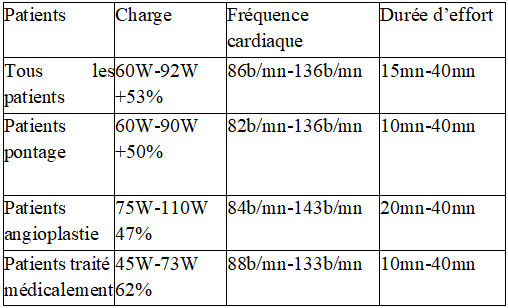Oldridge N, Guyatt G, Fischer M, et al. Cardiac rehabilitation after myocardial infarction. Combined experience of clinical trials. JAMA 1988 ; 260 : 945-50.
O’Connor G, Buring J, Yusuf S, et al. An overview of randomized trials of rehabilitation with exercise after myocardial infarction. Circulation 1989 ; 80 : 234-44.
Todd IC, Ballantyne D. Antianginal efficacy of exercise training : a comparison with betablockade. Br Heart J 1990 ; 64 : 14-9.
Delahaye F, Bory M, Cohen A et al. Recommandations de la société française de cardiologie concernant la prise en charge de l’infarctus du myocarde après la phase aiguë. Arch Mal Cœur 2001; 94:696-7384
Monpère C, Sellier P, Meurin P, et al. Recommandations de la Société Française de Cardiologie concernant la pratique de la réadaptation cardiovasculaire chez l’adulte. Version 2 Arch Mal Cœur 2002; 95: 963-97.
Karvonen MJ, Kentala E, Mustala O. The effects of training on heart rate. A longitudinal study. Ann Med Exp Biol 1957; 35: 307-15.
Recommandations de la Société Française de Cardiologie concernant la pratique des epreuves d’effort chez l’adulte en cardiologie. Arch Mal Cœur 1997; 90: 77-92
Pavy B :Exercise training for cardiac patients : Result of french multicentric register of complications during cardiac rehabilitation. Eur J Cardiovasc Prev Rehab 2003;12(3):290-291
WHO. Report on needs and action priorities in cardiac rehabilitation and secondary prevention in patients with coronary artery disease. Two consultations. April 1992; Tours (F) July 1992. Geneva: WHO, 1993.
Taylor RS, Brown A et al. Exercise-based rehabilitation for patients with coronary heart desease: systemic review and meta-analysis of randomized controlled trials. Am J Med 2004;116: 682-92.
Denollet J, Brutsaert DL Enhancing emotional well-being by comprehensive rehabilitation in patients with coronary heart disease. Eur Heart J. 1995;16: 1070–1078
Manheim C, Camici P, Chester MR et al. The problem of chronic refractory Angyna; report from the ESC Joint Study Group on the Treatment of Refractory Angina. Eu Heart J 2002; 23:335-70.
Monpere C, Rageolina A, vernochet P, Mirguet C, Thébaud N. Réinsertion professionnelle après réadaptation cardiovasculaire chez 128 patients coronariens suivis pendant sept ans. Résultats et réflexion médico-économique. Arch Mal Cœur 2000 ; 93 :797-806.
Hambrecht R, Walther C, Möbius S, et al. Percutaneous coronary angioplasty compared with exercise training in patients with stable coronary artery disease. A randomized trial. Circulation 2004; 109: 1371-8.
Euroaspire study group. Lifestyle and risk factor management and use of drug therapies in coronary patients from 15 countries. Principal results from euroaspire II. Euro Heart Survey Programme Eur Heart Journal 2001; 22:554-72.
Dorn J, Naughton J, Imamura D, et al. Results of a multicenter randomized clinical trial of exercise and long term survival in myocardial infarction patients. The National Exercise and Heart Disease Project (NEHDP). Circulation 1999 ; 100 : 1764-9.
Belardinelli R, Paolini I, Cianci G, et al. Exercise training intervention after coronary angioplasty. J Am Coll Cardiol 2001 ; 37 : 1891-900.
Wanamethee SG, Shaper AG, Walker MA. Physical activity and mortality in older men with diagnosed coronary heart disease. Circulation 2000; 102: 1358-63.
Keley G. Antihypertensive effects of aerobic exercise; a brief meta-analystic review of randomized controlled trials. Am J Hypertens 1994; 7: 115-9.
Engblom E, Hietanen EK, Hamalainen H, Kallio V, Inberg M, Knurs LR. Exercise habits and physical performance during comprehensive rehabilitation after coronary artery bypass surgery. Eur Heart J 1992; 13: 1053-1059
Broustet JP, Monpere P et groupe de travail « réadaptation cardiaque et épreuve d’effort » de la SFC, Enquête coopérative sur les suites de la chirurgie cardiaque au cours de la réadaptation cardiaque Arch. Mal Cœur; 1994 ; 87 :1267



